 |
Global Warming:
A Chilling Perspective
|
 A Brief
History of Ice Ages and Warming
A Brief
History of Ice Ages and Warming
 Causes
of Global Climate Change
Causes
of Global Climate Change
 Playing
with Numbers
Playing
with Numbers
 A Matter
of Opinion
A Matter
of Opinion
 Unraveling
the Earth's Temperature Record
Unraveling
the Earth's Temperature Record
 Stopping
Climate Change
Stopping
Climate Change
A Brief History
of Ice Ages and Warming
Global warming started long
before the "Industrial Revolution" and the invention of the internal
combustion engine. Global warming began 18,000 years ago as the earth started
warming its way out of the Pleistocene Ice Age-- a time when much
of North America, Europe, and Asia lay buried beneath great sheets of glacial
ice.
Earth's climate and the biosphere have been in constant flux, dominated
by ice ages and glaciers for the past several million years. We
are currently enjoying a temporary reprieve from the deep freeze.
Approximately every 100,000 years Earth's climate warms up temporarily.
These warm periods, called interglacial periods, appear to last
approximately 15,000 to 20,000 years before regressing back to a cold ice
age climate. At year 18,000 and counting our current interglacial vacation
from the Ice Age is much nearer its end than its beginning.
Global warming during Earth's current interglacial warm period
has greatly altered our environment and the distribution and diversity
of all life. For example:
 Approximately 15,000 years ago the earth
had warmed sufficiently to halt the advance of glaciers, and sea levels
worldwide began to rise.
Approximately 15,000 years ago the earth
had warmed sufficiently to halt the advance of glaciers, and sea levels
worldwide began to rise.
 By 8,000 years ago the land bridge across
the Bering Strait was drowned, cutting off the migration of men and animals
to North America from Asia.
By 8,000 years ago the land bridge across
the Bering Strait was drowned, cutting off the migration of men and animals
to North America from Asia.
 Since the end of the Ice Age, Earth's temperature
has risen approximately 16 degrees F and
sea levels have risen a total of 300 feet!
Forests have returned where once there was only ice.
Since the end of the Ice Age, Earth's temperature
has risen approximately 16 degrees F and
sea levels have risen a total of 300 feet!
Forests have returned where once there was only ice.
 Over the past 750,000 years of Earth's history,
Ice Ages have occurred at regular intervals, of approximately 100,000 years
each.
Over the past 750,000 years of Earth's history,
Ice Ages have occurred at regular intervals, of approximately 100,000 years
each.
Courtesy of Illinois
State Museum
During ice ages our planet is
cold, dry, and inhospitable-- supporting few forests but plenty of
glaciers and deserts. Like a spread of collosal bulldozers,
glaciers have scraped and pulverized vast stretches of Earth's surface
and completely destroyed entire regional ecosystems not once, but several
times. During Ice Ages winters were longer and more severe and ice sheets
grew to tremendous size, accumulating to thicknesses of up to 8,000 feet!.
They moved slowly from higher elevations to lower-- driven by gravity and
their tremendous weight. They left in their wake altered river courses,
flattened landscapes, and along the margins of their farthest advance,
great piles of glacial debris.
During the last 3 million years glaciers have at one time or another covered about 29% of Earth's land surface or about 17.14 million square miles (44.38 million sq. km.) . What did not lay beneath ice was a largely cold and desolate desert landscape, due in large part to the colder, less-humid atmospheric conditions that prevailed.
During the Ice Age summers were short and winters were brutal. Animal
life and especially plant life had a very tough time of it. Thanks to global
warming, that has all now changed, at least temporarily.

( view full size map) |
The World 18,000 Years Ago
Before "global warming" started 18,000 years ago most of the
earth was a frozen and arid wasteland. Over half of earth 's surface was
covered by glaciers
or extreme desert.
Forests were rare.
Not a very fun place to live. |

(view full size map) |
Our Present World
"Global warming" over the last 15,000 years has changed our
world from an ice box to a garden. Today extreme
deserts and glaciers have
largely given way to grasslands, woodlands, and forests.
Wish it could last forever, but . . . . |
In the 1970s concerned environmentalists
like Stephen Schneider of the National Center for Atmospheric Research
in Boulder, Colorado feared a return to another ice age due to manmade
atmospheric pollution blocking out the sun.
Since about 1940 the global climate did in fact appear to be cooling.
Then a funny thing happened-- sometime in the late 1970s temperature declines
slowed to a halt and ground-based recording stations during the 1980s and
1990s began reading small but steady increases in near-surface temperatures.
Fears of "global cooling"
then changed suddenly to "global warming,"--
the cited cause:
manmade atmospheric pollution causing a runaway greenhouse effect.
What does geologic history have to offer in sorting
through the confusion?
Quite a bit, actually.
 "If 'ice age' is used
to refer to long, generally cool, intervals during which glaciers advance
and retreat, we are still in one today. Our modern climate represents a
very short, warm period between glacial advances." Illinois State Museum
"If 'ice age' is used
to refer to long, generally cool, intervals during which glaciers advance
and retreat, we are still in one today. Our modern climate represents a
very short, warm period between glacial advances." Illinois State Museum
Periods of Earth warming
and cooling occur in cycles. This is well understood, as is the fact that
small-scale cycles of about 40 years exist within larger-scale cycles of
400 years, which in turn exist inside still larger scale cycles of 20,000
years, and so on.
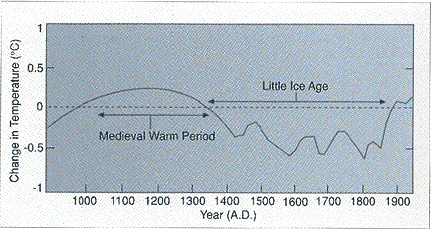
Example of regional variations in surface air
temperature for the last 1000 years, estimated from a variety of sources,
including temperature-sensitive tree growth indices and written records
of various kinds, largely from western Europe and eastern North America.
Shown are changes in regional temperature in ° C, from the baseline
value for 1900. Compiled by R. S. Bradley and J. A. Eddy based on J. T.
Houghton et al., Climate Change: The IPCC Assessment, Cambridge UniversityPress,
Cambridge, 1990 and published in EarthQuest, vol 5, no 1, 1991. Courtesy
of Thomas Crowley, Remembrance
of Things Past: Greenhouse Lessons from the Geologic Record
Earth's climate was in a cool period from A.D. 1400 to about A.D. 1860,
dubbed the "Little Ice Age."
This period was characterized by harsh winters, shorter growing seasons,
and a drier climate. The decline in global temperatures was a modest 1/2°
C, but the effects of this global cooling cycle were more pronounced in
the higher latitudes. The Little Ice Age has been blamed for a host of
human suffering including crop failures like the "Irish Potato Famine"
and the demise of the
medieval Viking colonies in Greenland.
Today we enjoy global temperatures which have warmed back to levels
of the so called "Medieval Warm Period,"
which existed from approximately A.D. 1000 to A.D. 1350.
 "...the Earth was evidently
coming out of a relatively cold period in the 1800s so that warming in
the past century may be part of this natural recovery."
"...the Earth was evidently
coming out of a relatively cold period in the 1800s so that warming in
the past century may be part of this natural recovery."
Dr. John R. Christy
(leading climate and atmospheric science
expert- U. of Alabama in Huntsville) (5)
 Global
warming alarmists maintain that global temperatures have increased since
about A.D. 1860 to the present as the result of the so-called "Industrial Revolution,"-- caused by releases
of large amounts of greenhouse gases (principally carbon dioxide)
from manmade sources into the atmosphere causing a runaway "Greenhouse Effect."
Global
warming alarmists maintain that global temperatures have increased since
about A.D. 1860 to the present as the result of the so-called "Industrial Revolution,"-- caused by releases
of large amounts of greenhouse gases (principally carbon dioxide)
from manmade sources into the atmosphere causing a runaway "Greenhouse Effect."
Was man really responsible for pulling the Earth out of the Little Ice
Age with his industrial pollution? If so, this may be one of the greatest
unheralded achievements of the Industrial Age!
Unfortunately, we tend to overestimate our actual impact on the planet.
In this case the magnitude of the gas emissions involved, even by the most
aggressive estimates of atmospheric warming by greenhouse gases, is inadequate
to account for the magnitude of temperature increases. So what causes the
up and down cycles of global climate change?
Causes of
Global Climate Change
Climate change is controlled
primarily by cyclical eccentricities in Earth's
rotation and orbit, as well as variations in the sun's energy output.
"Greenhouse gases" in
Earth's atmosphere also influence Earth's temperature, but in a much smaller
way. Human additions to total greenhouse gases play a still smaller role,
contributing about 0.2% - 0.3% to Earth's
greenhouse effect.
Major Causes of Global
Temperature Shifts
(1) Astronomical Causes
- 11 year and 206
 year cycles: Cycles of solar variability ( sunspot
activity
year cycles: Cycles of solar variability ( sunspot
activity  )
)
- 21,000 year cycle: Earth's combined tilt and elliptical
orbit around the Sun ( precession
of the equinoxes
 )
)
- 41,000 year cycle: Cycle of the
+/- 1.5° wobble in Earth's orbit (
tilt
 )
) - 100,000 year cycle: Variations
in the shape of Earth's elliptical orbit (
cycle
of eccentricity
 )
)
(2) Atmospheric Causes
- Heat retention: Due to atmospheric
gases, mostly gaseous water vapor (not droplets), also carbon dioxide,
methane, and a few other miscellaneous gases-- the "greenhouse
effect"
- Solar reflectivity: Due to white clouds, volcanic dust, polar ice caps
(3) Tectonic Causes
- Landmass distribution: Shifting
continents (continental drift) causing
changes in circulatory patterns of ocean currents. It seems that whenever
there is a large land mass at one of the Earth's poles, either the north
pole or south pole, there are ice ages.
- Undersea ridge activity: "Sea
floor spreading" (associated with continental drift) causing
variations in ocean displacement.
-
For more details see:
http://www.ngdc.noaa.gov/paleo/milankovitch.html 
http://www.abc.net.au/science/news/enviro/EnviroRepublish_233658.htm

Playing with Numbers
Global climate and temperature
cycles are the result of a complex interplay between a variety of causes.
Because these cycles and events overlap, sometimes compounding one another,
sometimes canceling one another out, it is inaccurate to imply a statistically
significant trend in climate or temperature patterns from just a few years
or a few decades of data.
Unfortunately, a lot of disinformation about where Earth's climate is
heading is being propagated by "scientists" who use improper
statistical methods, short-term temperature trends, or faulty computer
models to make analytical and anecdotal projections about the significance
of man-made influences to Earth's climate.
During the last 100 years there have been two
general cycles of warming and cooling recorded in the U.S. We
are currently in the second warming cycle. Overall, U.S. temperatures
show no significant warming trend over the
last 100 years (1). This has been well - established but not
well - publicized.
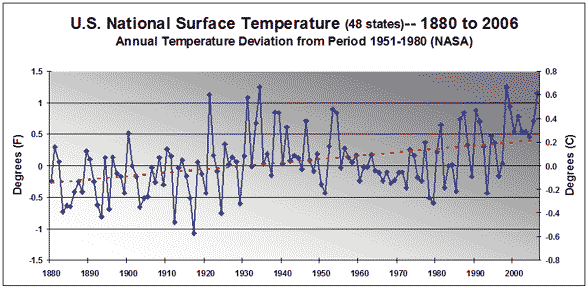
Each year Government press releases declare the previous year to be
the "hottest year on record." The UN's executive summary on climate change, issued in January 2001, insists that the 20th century was the warmest in the last millennium. The news media distribute these stories and people generally believed them to be true. However, as most climatologists know, these reports generally are founded on ground-based temperature readings, which are misleading. The
more meaningful and precise orbiting satellite data for the same period
(which are generally not cited by the press) have year after year showed
little or no warming.
insists that the 20th century was the warmest in the last millennium. The news media distribute these stories and people generally believed them to be true. However, as most climatologists know, these reports generally are founded on ground-based temperature readings, which are misleading. The
more meaningful and precise orbiting satellite data for the same period
(which are generally not cited by the press) have year after year showed
little or no warming.
Dr. Patrick Michaels has demonstrated this effect is a common problem
with ground- based recording stations, many of which originally were located
in predominantly rural areas, but over time have suffered background bias
due to urban sprawl and the encroachment of concrete and asphalt ( the
"urban heat island effect").
The result has been an upward distortion of increases in ground temperature
over time(2). Satellite measurements are not limited in this way, and are
accurate to within 0.1° C. They are widely recognized by scientists
as the most accurate data available. Significantly,
global temperature readings from orbiting satellites show no significant
warming in the 18 years they have been continuously recording and returning
data (1).
A Matter of Opinion
Has manmade pollution in
the form of carbon dioxide (CO2) and other gases caused a runaway Greenhouse
Effect and Global Warming?
Before joining the mantra, consider the following:
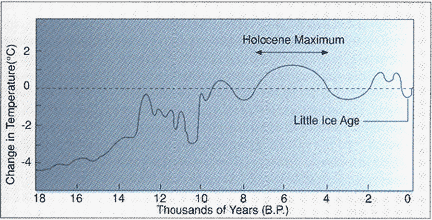
Compiled by R.S. Bradley and J.A. Eddy based on
J.T. Houghton et al., Climate Change: The IPCC Assessment, Cambridge University
Press, Cambridge, 1990 and published in EarthQuest, vo. 1, 1991.
Courtesy of Thomas Crowley, Remembrance
of Things Past: Greenhouse Lessons from the Geologic Record |
1. The idea that man-made pollution
is responsible for global warming is not supported by historical fact.
The period known as the Holocene Maximum is a good example-- so-named
because it was the hottest period in human history. The interesting thing
is this period occurred approximately 7500 to 4000 years B.P. (before present)--
long before humans invented industrial pollution. |
| 
(view full-size image)
Figure 1 |
2. CO2 in our atmosphere
has been increasing steadily for the last 18,000 years-- long before humans
invented smokestacks ( Figure 1). Unless
you count campfires and intestinal gas, man played no role in the pre-industrial
increases.
As illustrated in this chart of Ice Core data from the Soviet
Station Vostok in Antarctica, CO2 concentrations in earth's atmosphere
move with temperature. Both temperatures and CO2 have been on the increase
for 18,000 years. Interestingly, CO2 lags an average of about 800 years
behind the temperature changes-- confirming that CO2 is not a primary
driver of the temperature changes (9).
Incidentally, earth's temperature and CO2 levels today have reached
levels similar to a previous interglacial cycle of 120,000 - 140,000 years
ago. From beginning to end this cycle lasted about 20,000 years. This is
known as the Eemian Interglacial Period and the earth returned to
a full-fledged ice age immediately afterward. |
| 
view full-size image
Figure 3 |
4.
If global warming is caused by CO2 in the atmosphere
then does CO2 also cause increased sun activity too?
This chart adapted after Nigel Calder (6) illustrates
that variations in sun
activity are generally proportional to both variations in
atmospheric CO2
and atmospheric temperature
(Figure 3).
Put another way, rising Earth temperatures and increasing CO2 may be
"effects" and our own sun
the "cause". |
FUN FACTS about CARBON DIOXIDE
 Of the 186 billion tons of carbon from CO2
that enter earth's atmosphere each year from all sources, only 6 billion
tons are from human activity. Approximately 90 billion tons come from biologic
activity in earth's oceans and another 90 billion tons from such sources
as volcanoes and decaying land plants.
Of the 186 billion tons of carbon from CO2
that enter earth's atmosphere each year from all sources, only 6 billion
tons are from human activity. Approximately 90 billion tons come from biologic
activity in earth's oceans and another 90 billion tons from such sources
as volcanoes and decaying land plants.
 At 380 parts per million CO2 is a minor constituent
of earth's atmosphere-- less than 4/100ths of
1% of all gases present. Compared to former geologic times, earth's
current atmosphere is CO2-
impoverished.
At 380 parts per million CO2 is a minor constituent
of earth's atmosphere-- less than 4/100ths of
1% of all gases present. Compared to former geologic times, earth's
current atmosphere is CO2-
impoverished.
 CO2 is odorless, colorless, and tasteless.
Plants absorb CO2 and emit oxygen as a waste product. Humans and animals
breathe oxygen and emit CO2 as a waste product. Carbon dioxide is a nutrient,
not a pollutant, and all life-- plants and animals alike-- benefit from
more of it. All life on earth is carbon-based and CO2 is an essential ingredient.
When plant-growers want to stimulate plant growth, they introduce more
carbon dioxide.
CO2 is odorless, colorless, and tasteless.
Plants absorb CO2 and emit oxygen as a waste product. Humans and animals
breathe oxygen and emit CO2 as a waste product. Carbon dioxide is a nutrient,
not a pollutant, and all life-- plants and animals alike-- benefit from
more of it. All life on earth is carbon-based and CO2 is an essential ingredient.
When plant-growers want to stimulate plant growth, they introduce more
carbon dioxide.
 CO2 that goes into the atmosphere does not
stay there but is continually recycled by terrestrial plant life and earth's
oceans-- the great retirement home for most terrestrial carbon dioxide.
CO2 that goes into the atmosphere does not
stay there but is continually recycled by terrestrial plant life and earth's
oceans-- the great retirement home for most terrestrial carbon dioxide.
 If we are in
a global warming crisis today, even the most aggressive and costly proposals
for limiting industrial carbon dioxide emissions would have a negligible
effect on global climate!
If we are in
a global warming crisis today, even the most aggressive and costly proposals
for limiting industrial carbon dioxide emissions would have a negligible
effect on global climate!
The case for a "greenhouse
problem" is made by environmentalists, news anchormen , and special
interests who make inaccurate and misleading statements about global warming
and climate change. Even though people may be skeptical of such rhetoric
initially, after awhile people start believing it must be true because
we hear it so often.
 "We have to offer up scary
scenarios, make simplified, dramatic statements, and make little mention
of any doubts we may have. Each of us has to decide what the right balance
is between being effective and being honest."
"We have to offer up scary
scenarios, make simplified, dramatic statements, and make little mention
of any doubts we may have. Each of us has to decide what the right balance
is between being effective and being honest."
Stephen Schneider (leading advocate of the global warming
theory)
(in interview for Discover magazine, Oct
1989)
 "In the United States...we
have to first convince the American People and the Congress that the climate
problem is real."
"In the United States...we
have to first convince the American People and the Congress that the climate
problem is real."
former
President Bill Clinton in a 1997 address to the United Nations
 Nobody is interested in solutions
if they don't think there's a problem. Given that starting point, I believe
it is appropriate to have an over-representation of factual presentations
on how dangerous (global warming) is, as a predicate for opening up the
audience to listen to what the solutions are...
Nobody is interested in solutions
if they don't think there's a problem. Given that starting point, I believe
it is appropriate to have an over-representation of factual presentations
on how dangerous (global warming) is, as a predicate for opening up the
audience to listen to what the solutions are...
former Vice President Al Gore
(now, chairman
and co-founder of Generation Investment Management--
a
London-based business that sells carbon credits)
(in interview
with Grist
Magazine  May 9, 2006, concerning his book, An Inconvenient
Truth)
May 9, 2006, concerning his book, An Inconvenient
Truth)
 "In the long run, the
replacement of the precise and disciplined language of science by the misleading
language of litigation and advocacy may be one of the more important sources
of damage to society incurred in the current debate over global warming."
"In the long run, the
replacement of the precise and disciplined language of science by the misleading
language of litigation and advocacy may be one of the more important sources
of damage to society incurred in the current debate over global warming."
Dr. Richard S. Lindzen
(leading climate and atmospheric science expert- MIT) (3)
 "Researchers pound the global-warming
drum because they know there is politics and, therefore, money behind it.
. . I've been critical of global warming and am persona non grata."
"Researchers pound the global-warming
drum because they know there is politics and, therefore, money behind it.
. . I've been critical of global warming and am persona non grata."
Dr. William
Gray
(Professor of Atmospheric Sciences at Colorado
State University, Fort Collins, Colorado and leading expert of hurricane
prediction )
(in an interview for the Denver Rocky Mountain
News, November 28, 1999)
 "Scientists who want to attract
attention to themselves, who want to attract great funding to themselves,
have to (find a) way to scare the public . . . and this you can achieve
only by making things bigger and more dangerous than they really are."
"Scientists who want to attract
attention to themselves, who want to attract great funding to themselves,
have to (find a) way to scare the public . . . and this you can achieve
only by making things bigger and more dangerous than they really are."
Petr Chylek
(Professor of Physics and
Atmospheric Science, Dalhousie University, Halifax, Nova Scotia)
Commenting on reports by other researchers that Greenland's glaciers
are melting.
(Halifax Chronicle-Herald, August 22,
2001) (8)
 "Even if the theory of global
warming is wrong, we will be doing the right thing -- in terms of economic
policy and environmental policy."
"Even if the theory of global
warming is wrong, we will be doing the right thing -- in terms of economic
policy and environmental policy."
Tim Wirth , while U.S. Senator, Colorado.
After
a short stint as United Nations Under-Secretary for Global Affairs (4)
he now serves as President, U.N. Foundation, created
by Ted Turner and his
$1 billion "gift"
 "No matter if the science
is all phony, there are collateral environmental benefits.... Climate change
[provides] the greatest chance to bring about justice and equality in the
world."
"No matter if the science
is all phony, there are collateral environmental benefits.... Climate change
[provides] the greatest chance to bring about justice and equality in the
world."
Christine Stewart, former Minister of the Environment of
Canada
quote from the Calgary Herald, 1999
Unraveling the Earth's Temperature Record
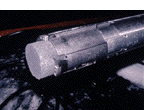 Because
accumulating layers of glacial ice display annual bands which can be dated,
similar to annual rings of a tree, the age of ice core samples can be determined.
Continuous ice cores from borings as much as two miles long have been extracted
from permanent glaciers in Greenland, Antarctica, and Siberia. Bubbles
of entrapped air in the ice cores can be analyzed to determine not only
carbon dioxide and methane concentrations, but also atmospheric temperatures
can be determined from analysis of entrapped hydrogen and oxygen.
Because
accumulating layers of glacial ice display annual bands which can be dated,
similar to annual rings of a tree, the age of ice core samples can be determined.
Continuous ice cores from borings as much as two miles long have been extracted
from permanent glaciers in Greenland, Antarctica, and Siberia. Bubbles
of entrapped air in the ice cores can be analyzed to determine not only
carbon dioxide and methane concentrations, but also atmospheric temperatures
can be determined from analysis of entrapped hydrogen and oxygen.
ice core photo by: Vin Morgan
Palaeo
Environment (Ice Cores) Field Work
Based on historical air temperatures inferred from ice core analyses
from the Antarctic Vostok station in 1987, relative to the average global
temperature in 1900 it has been determined that from 160,000 years ago
until about 18,000 years ago Earth temperatures were on average about 3°
C cooler than today.
Except for two relatively brief interglacial episodes, one peaking about
125,000 years ago (Eemian Interglacial), and the other beginning about
18,000 years ago (Present Interglacial), the Earth has been under siege
of ice for the last 160,000 years.
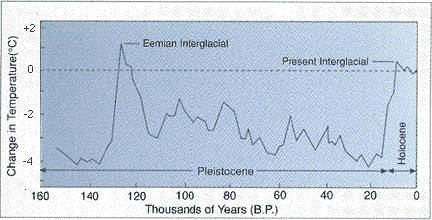
Compiled by R.S. Bradley and J.A. Eddy based on
J. Jouzel et al., Nature vol. 329. pp. 403-408, 1987 and published in EarthQuest,
vol. 5, no. 1, 1991. Courtesy of Thomas Crowley, Remembrance
of Things Past: Greenhouse Lessons from the Geologic Record
As illustrated in this final graph, over the past 800,000 years the
Earth has undergone major swings in warming and cooling at approximately
100,000 year intervals, interrupted by minor warming cycles at shorter
intervals. This represents periods of glacial expansion, separated by distinct
but relatively short-lived periods of glacial retreat.
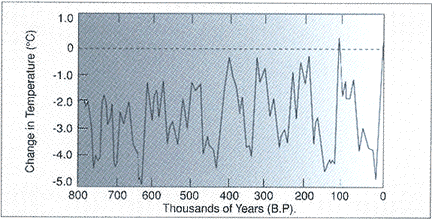
Temperature data inferred from measurements of
the ratio of oxygen isotope ratios in fossil plankton that settled to the
sea floor, and assumes that changes in global temperature approximately
tracks changes in the global ice volume. Based on
data from J. Imbrie, J.D. Hays, D.G. Martinson, A. McIntyre, A.C. Mix,
J.J. Morley, N.G. Pisias, W.L. Prell, and N.J. Shackleton, in A. Berger,
J. Imbrie, J. Hats, G. Kukla, and B. Saltzman, eds., Milankovitch and Climate,
Dordrecht, Reidel, pp. 269-305, 1984.Courtesy of Thomas Crowley, Remembrance
of Things Past: Greenhouse Lessons from the Geologic Record
The Polar Ice Cap Effect
 As
long as the continent of Antarctica exists at the southern pole of our
planet we probably will be repeatedly pulled
back into glacial ice ages. This occurs because ice caps, which cannot
attain great thickness over open ocean, can and do achieve great thickness
over a polar continent-- like Antarctica. Antarctica used to be located
near the equator, but over geologic time has moved by continental
drift to its present location at the south pole. Once established,
continental polar ice caps act like huge cold sinks, taking over the climate
and growing bigger during periods of reduced solar output. Part of the
problem with shaking off the effects of an ice age is once ice caps are
established, they cause solar radiation to be reflected back into space,
which acts to perpetuate global cooling. This increases the size of ice
caps which results in reflection of even more radiation, resulting in more
cooling, and so on.
As
long as the continent of Antarctica exists at the southern pole of our
planet we probably will be repeatedly pulled
back into glacial ice ages. This occurs because ice caps, which cannot
attain great thickness over open ocean, can and do achieve great thickness
over a polar continent-- like Antarctica. Antarctica used to be located
near the equator, but over geologic time has moved by continental
drift to its present location at the south pole. Once established,
continental polar ice caps act like huge cold sinks, taking over the climate
and growing bigger during periods of reduced solar output. Part of the
problem with shaking off the effects of an ice age is once ice caps are
established, they cause solar radiation to be reflected back into space,
which acts to perpetuate global cooling. This increases the size of ice
caps which results in reflection of even more radiation, resulting in more
cooling, and so on.
Continental polar ice caps seem to play a particularly important role
in ice ages when the arrangement of continental land masses restrict the
free global circulation of equatorial ocean currents. This is the case
with the continents today, as it was during the Carboniferous
Ice Age when the supercontinent Pangea stretched from pole to
pole 300 million years ago.
Stopping Climate Change
Putting things in perspective,
geologists tell us our present warm climate is a mere blip in the history
of an otherwise cold Earth. Frigid Ice Age temperatures have been the rule,
not the exception, for the last couple of million years. This kind of world
is not totally inhospitable, but not a very fun place to live, unless you
are a polar bear.
Some say we are "nearing
the end of our minor interglacial period" , and may in fact be
on the brink of another Ice Age. If this is true, the last thing we should
be doing is limiting carbon dioxide emissions into the atmosphere, just
in case they may have a positive effect in sustaining present temperatures.
The smart money, however, is betting that there is some momentum left in
our present warming cycle. Environmental advocates agree: resulting in
a shift of tactics from the "global cooling" scare of
the 1970s to the "global warming" threat of the 1980s
and 1990s.
Now, as we begin the 21st century the terminology is morphing toward"climate
change," whereby no matter the direction of temperature trends--
up or down-- the headlines can universally blame humans while avoiding
the necessity of switching buzz-words with the periodicity of solar cycles.
Such tactics may, however, backfire as peoples' common sensibilities are
at last pushed over the brink.
Global climate cycles of warming and cooling have been a natural phenomena
for hundreds of thousands of years, and it is unlikely that these cycles
of dramatic climate change will stop anytime soon. We currently enjoy a
warm Earth. Can we count on a warm Earth forever? The answer is most likely...
no.
Since the climate has always been changing and will likely continue
of its own accord to change in the future, instead of crippling the U.S.
economy in order to achieve small reductions in global warming effects
due to manmade additions to atmospheric carbon dioxide, our resources may
be better spent making preparations to adapt to global cooling and global
warming, and the inevitable consequences of fluctuating ocean levels, temperatures,
and precipitation that accompany climatic change.
Supporting this view is British scientist Jane
Francis, who maintains:
" What we are seeing really is just another interglacial phase
within our big icehouse climate." Dismissing political calls for
a global effort to reverse climate change, she said, " It's really
farcical because the climate has been changing constantly... What we should
do is be more aware of the fact that it is changing and that we should
be ready to adapt to the change."
 |
 |
|
THIS PAGE BY:
Monte Hieb
This site last updated October 5, 2007 |
| Previous |
Table of Contents |
|
References
(1) A scientific Discussion of Climate Change, Sallie Baliunas, Ph.D., Harvard- Smithsonian Center for Astrophysics and Willie Soon, Ph.D., Harvard- Smithsonian Center for Astrophysics.
(2) The Effects
of Proposals for Greenhouse Gas Emission Reduction; Testimony of Dr.
Patrick J. Michaels, Professor of Environmental Sciences, University of
Virginia, before the Subcommittee on Energy and Environment of the Committee
on Science, United States House of Representatives
(3) Statement Concerning Global Warming--
Presented to the Senate Committee on Environmental and Public Works, June
10, 1997, by Dr. Richard S. Lindzen, Massachusetts Institute of Technology
(4) Excerpts from,"Our
Global Future: Climate Change", Remarks by Under Secretary for
Global affairs, T. Wirth, 15 September 1997. Site maintained by The Globe - Climate
Change Campaign
(5) Testimony of John R. Christy to the
Committee on Environmental and Public Works, Department of Atmospheric
Science and Earth System Science Laboratory, University of Alabama in Huntsville,
July 10, 1997.
(6) The Carbon Dioxide Thermometer and the Cause of Global Warming;
Nigel Calder,-- Presented at a seminar SPRU (Science and Technology Policy
Research), University of Sussex, Brighton, England, October 6, 1998.
(7) Variation in cosmic ray flux and global cloud coverage: a
missing link in solar-climate relationships; H. Svensmark and E.
Friis-Christiansen, Journal of Atmospheric and Solar- Terrestrial Physics,
vol. 59, pp. 1225 - 1232 (1997).
(8) First International Conference on Global Warming and the Next
Ice Age; Dalhousie University, Halifax, Nova Scotia, sponsored by the
Canadian Meteorological and Oceanographic Society and the American Meteorological
Society, August 21-24, 2001.
(9) Ice Core Studies Prove CO2 Is Not the Powerful Climate Driver Climate
Alarmists Make It Out to Be; CO2 Science;
Volume 6, Number 26: 25 June 2003; http://www.co2science.org/articles/V6/N26/EDIT.php
Additional Reading
Understanding
Common Climate Claims: Dr. Richard S. Lindzen; Draft paper to appear
in the Proceedings of the 2005 Erice Meeting of the World Federation of
Scientists on Global Emergencies.
Geological Constraints
on Global Climate Variability: Dr. Lee C. Gerhard-- A variety of natural
climate drivers constantly change our climate. A slide format presentation.
8.5 MB.
Thoughts of Global Warming: "The bottom line is that climatic change is a given. It is inescapable, it happens. There is no reason to be very concerned about it or spend bazillions of dollars to try and even things out.
NOAA Paleoclimatology:
An educational trip through earths distant and recent past. Also contains
useful information and illustrations relating to the causes of climate
change.
Cracking the Ice Age:
From the PBS website-- NOVA online presents a brief tour of the causes
of global warming.
Little Ice Age (Solar Influence - Temperature): From the online magazine, "CO2 Science."
Solar Variability
and Climate Change:  by Willie Soon, January 10, 2000
by Willie Soon, January 10, 2000
Earth's
Fidgeting Climate: NASA Science News "It may surprise many people
that science cannot deliver an unqualified, unanimous answer about something
as important as climate change"

A Brief History of Ice Ages and Warming
Causes of Global Climate Change
Playing with Numbers
A Matter of Opinion
Unraveling the Earth's Temperature Record
Stopping Climate Change
Approximately 15,000 years ago the earth had warmed sufficiently to halt the advance of glaciers, and sea levels worldwide began to rise.
By 8,000 years ago the land bridge across the Bering Strait was drowned, cutting off the migration of men and animals to North America from Asia.
Since the end of the Ice Age, Earth's temperature has risen approximately 16 degrees F and sea levels have risen a total of 300 feet! Forests have returned where once there was only ice.



![]() "If 'ice age' is used
to refer to long, generally cool, intervals during which glaciers advance
and retreat, we are still in one today. Our modern climate represents a
very short, warm period between glacial advances." Illinois State Museum
"If 'ice age' is used
to refer to long, generally cool, intervals during which glaciers advance
and retreat, we are still in one today. Our modern climate represents a
very short, warm period between glacial advances." Illinois State Museum





 Because
accumulating layers of glacial ice display annual bands which can be dated,
similar to annual rings of a tree, the age of ice core samples can be determined.
Continuous ice cores from borings as much as two miles long have been extracted
from permanent glaciers in Greenland, Antarctica, and Siberia. Bubbles
of entrapped air in the ice cores can be analyzed to determine not only
carbon dioxide and methane concentrations, but also atmospheric temperatures
can be determined from analysis of entrapped hydrogen and oxygen.
Because
accumulating layers of glacial ice display annual bands which can be dated,
similar to annual rings of a tree, the age of ice core samples can be determined.
Continuous ice cores from borings as much as two miles long have been extracted
from permanent glaciers in Greenland, Antarctica, and Siberia. Bubbles
of entrapped air in the ice cores can be analyzed to determine not only
carbon dioxide and methane concentrations, but also atmospheric temperatures
can be determined from analysis of entrapped hydrogen and oxygen.

 As
long as the continent of Antarctica exists at the southern pole of our
planet we probably will be repeatedly
As
long as the continent of Antarctica exists at the southern pole of our
planet we probably will be repeatedly